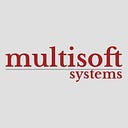SAP FICO Interview Questions
The SAP FICO Online Training and Certification Course offered by Multisoft Systems is a comprehensive program designed to equip learners with in-depth knowledge and skills in SAP Financial Accounting (FI) and Controlling (CO) modules. Delivered through an interactive online platform, participants are granted access to extensive learning materials, real-world case studies, and live projects to ensure hands-on experience. Upon completion, participants are awarded with a SAP FICO certification, validating their expertise in optimizing financial operations and ensuring accuracy, efficiency, and strategic financial management in diverse business environments.
Here are some frequently asked interview questions:
Q1. What is SAP FICO?
SAP FICO stands for SAP Financial Accounting and Controlling, a module in SAP ERP, focused on financial accounting and management. It ensures real-time tracking of business transactions, financial conditions, and performance analytics, enabling informed decision-making and streamlined financial operations.
Q2. Explain the organizational structure in SAP FICO.
The organizational structure in SAP FICO comprises the client, company code, business areas, and segments, each playing a crucial role in organizing and managing financial data efficiently. These hierarchical levels facilitate detailed, organized, and comprehensive financial reporting.
Q3. What is a chart of accounts in SAP FICO?
A chart of accounts is a structured list of all general ledger accounts used by a company. It categorizes and organizes a company’s financial information, ensuring accurate tracking, recording, and reporting of financial transactions.
Q4. What are the main components of SAP FICO?
SAP FI and CO are the two core components. FI focuses on external reporting, while CO handles internal managerial and cost-controlling processes, ensuring a balanced approach to financial management.
Q5. Explain the terms “debit” and “credit” in SAP FICO.
In SAP FICO, “debit” refers to transaction entries signifying an increase in assets or expenses, while “credit” indicates an increase in liabilities, equity, or income. These entries are fundamental to double-entry bookkeeping.
Q6. How does SAP FICO integrate with other SAP modules?
SAP FICO is highly integrative, working seamlessly with other modules like SAP MM, SAP SD, and SAP PP. Financial data and transactions flow automatically, ensuring accuracy, efficiency, and real-time updates in financial reporting and analytics.
Q7. Explain asset classes in SAP FICO.
Asset classes are a systematic categorization of assets of similar types. In SAP FICO, they help in managing and evaluating assets, ensuring consistency in asset records, and adherence to legal requirements for asset management and depreciation.
Q8. What is the accounts payable process in SAP FICO?
Accounts payable in SAP FICO involve managing and recording a company’s obligations to pay off short-term debts to its vendors. It streamlines vendor transactions, automatic postings, and reconciliation processes ensuring accuracy and efficiency.
Q9. How is bank reconciliation done in SAP FICO?
Bank reconciliation in SAP FICO involves matching the bank’s balances with the company’s financial records. Discrepancies are identified and analyzed, and adjustments are made to ensure accurate financial reporting and insights.
Q10. What is dunning in SAP FICO?
Dunning in SAP FICO is a process to systematically remind or warn customers of their overdue payments. It helps in managing and mitigating the risks associated with accounts receivables.
Q11. Explain the cost center and profit center in SAP FICO.
Cost centers are departments that incur costs while profit centers are responsible for revenues and profits. In SAP FICO, they helps in tracking, analyzing, and optimizing costs and profits, ensuring organizational financial health.
Q12. How do you handle foreign currency transactions in SAP FICO?
SAP FICO facilitates handling foreign currency transactions through automatic currency conversions, real-time exchange rate updates, and features to manage currency risks, ensuring accurate and compliant international financial transactions.
Q13. What are the different types of reports generated using SAP FICO?
SAP FICO supports a variety of reports including financial statements, tax returns, segment reporting, and others. It ensures comprehensive, accurate, and timely financial information for informed decision-making.
Q14. Explain fiscal year variant.
Fiscal year variant defines the financial year’s structure. In SAP FICO, it can be a calendar year or a year different from the calendar year, assisting in tailored financial reporting and analysis.
Q15. What are posting periods?
Posting periods in SAP FICO are specific time segments like months or quarters, allowing the systematic recording and management of financial transactions, ensuring organized, timely, and accurate financial data handling.
Q16. What is internal order in SAP FICO?
Internal orders are used to track the costs of a specific job or task, like a marketing campaign or a project. It allows for detailed monitoring, analysis, and reporting of expenses, enhancing cost management and budget control.
Q17. What role does the general ledger play in SAP FICO?
The general ledger is central to SAP FICO, consolidating data from all accounts to provide comprehensive insights into the financial condition. It supports real-time, accurate reporting and facilitates compliance with international accounting standards.
Q18. Can you explain the process of the automatic payment program in SAP FICO?
The automatic payment program streamlines the payment process for vendors and creditors. It automates payment transactions, batch processing, and data entry, enhancing efficiency, accuracy, and security in managing payables.
Q19. What are variants in SAP FICO, and how are they used?
Variants in SAP FICO are used to save parameters of reports and field selections. They streamline data entry and reporting processes, ensuring consistency, efficiency, and customized data handling for diverse business needs.
Q20. How is tax calculated in SAP FICO?
Tax calculation in SAP FICO is automated, adhering to regional and international tax laws. It integrates with transactions and accounting processes to ensure accurate, compliant, and efficient tax calculation, reporting, and management.
